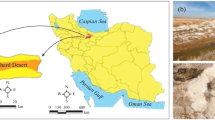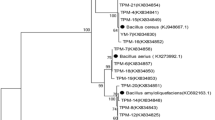Abstract
The screening for hydrolases-producing, halotolerant, and spore-forming gram-positive bacteria from the root, rhizosphere, and non-rhizosphere soil of Blutaparon portulacoides, a plant found in the Restinga de Jurubatiba located at the northern region of Rio de Janeiro State, Brazil, resulted in the isolation of 22 strains. These strains were identified as Halobacillus blutaparonensis (n = 2), Oceanobacillus picturae (n = 5), and Oceanobacillus iheyensis (n = 15), and all showed the ability to produce different extracellular enzymes. A total of 20 isolates (90.9 %) showed activity for protease, 5 (22.7 %) for phytase, 3 (13.6 %) for cellulase, and 2 (9.1 %) for amylase. Some bacterial strains were capable of producing three (13.6 %) or two (9.1 %) distinct hydrolytic enzymes. However, no bacterial strain with ability to produce esterase and DNase was observed. The isolate designated M9, belonging to the species H. blutaparonensis, was the best producer of protease and also yielded amylase and phytase. This strain was chosen for further studies regarding its protease activity. The M9 strain produced similar amounts of protease when grown either without or with different NaCl concentrations (from 0.5 to 10 %). A simple inspection of the cell-free culture supernatant by gelatin-sodium dodecyl sulfate-polyacrylamide gel electrophoresis (SDS-PAGE) revealed the presence of three major alkaline proteases of 40, 50, and 70 kDa, which were fully inhibited by phenylmethylsulfonyl fluoride (PMSF) and tosyl-l-phenylalanine chloromethyl ketone (TPCK) (two classical serine protease inhibitors). The secreted proteases were detected in a wide range of temperature (from 4 to 45 °C) and their hydrolytic activities were stimulated by NaCl (up to 10 %). The serine proteases produced by the M9 strain cleaved gelatin, casein, albumin, and hemoglobin, however, in different extensions. Collectively, these results suggest the potential use of the M9 strain in biotechnological and/or industrial processes.







Similar content being viewed by others
References
Myers, J. H., Simberloff, D., Kuris, A. M., & Carey, J. R. (2000). Letters in Applied Microbiology, 15, 316–320.
Araújo, D. S. D., Scarano, F. R., Sá, C. F. C., Kurtz, B. C., Zaluar, H. L. T., Montezuma, R. C. M., & Oliveira, R. C. (1998). Revista Brasileira de Zoologia, 18, 39–62.
Kelecom, A., Reis, G. L., Fevereiro, P. C., Silva, J. G., Santos, M. G., Mello Neto, C. B., Gonzalez, M. S., Gouvea, R. C., & Almeida, G. S. (2002). Anais da Academia Brasileira de Ciências, 74, 171–181.
Bernaardi, H., & Seeliger, U. (1989). Ciência & Cultura, 41, 1110–1113.
Ferreira, E. O., & Dias, D. A. A. (2000). Phytochemistry, 53, 145–147.
Barbosa, D. C., Von Der Weid, I., Vaisman, N., & Seldin, L. (2006). Journal of Microbiology and Biotechnology, 16, 193–199.
Ventosa, A., Nieto, J. J., & Oren, A. (1998). Microbiology and Molecular Biology Reviews, 62, 504–544.
Galinski, E. A. (1993). Cellular and Molecular Life Sciences, 49, 487–496.
Fujinami, S., & Fujisawa, M. (2010). Environmental Technology, 31, 845–856.
Gupta, R., Beg, K. Q., & Lorenz, P. (2002). Applied Microbiology and Biotechnology, 59, 15–32.
Seldin, L. V., Elsas, J. D., & Penido, E. G. C. (1983). Plant and Soil, 70, 243–255.
Williams, S. T., Goodfellow, M., Alderson, G., Wellington, E., Sneath, P. H., & Sackin, M. J. (1983). Journal of Microbiology, 129, 1743–1813.
Mishra, S., & Behera, N. (2008). African Journal of Biotechnology, 7, 3326–3331.
Bairagi, A., Ghosh, K. S., Sem, S. K., & Ray, A. (2002). Aquaculture International, 10, 109–121.
Rosado, A. S., Azevedo, F. S., Cruz, D. W., Van Elsas, J. D., & Seldin, L. (1998). Journal of Applied Microbiology, 84, 216–226.
Schoofs, A., Odds, F. C., Colebunders, R., Leven, M., & Goussens, H. (1997). European Journal of Clinical Microbiology & Infectious Diseases, 16, 296–300.
MacFaddin, J. D. (1985). Willians & Wilkins, Baltimore, 1, 275–284
Price, M. F., Wilkinson, I. D., & Gentry, L. O. (1982). Sabouraudia, 15, 179–185.
Alvarez, V. M., Von der Weid, I., Seldin, L., & Santos, A. L. S. (2006). Letters in Applied Microbiology, 43, 625–630.
Lowry, O. H., Rosebrough, N. J., Farr, A. L., & Randall, R. J. (1951). The Journal of Biological Chemistry, 193, 265–275.
Heussen, C., & Dowdle, E. B. (1980). Analytical Biochemistry, 102, 196–202.
Bernardi, H., Cordazzo, C. V., & Costa, C. S. B. (1987). Ciência & Cultura, 35, 545–547.
Moreno, M. L., Piubeli, F., Bonfá, M. R., García, M. T., Durrant, L. R., & Mellado, E. (2012). Journal of Applied Microbiology, 113, 550–559.
Sánchez-Porro, C., Mellado, E., Bertoldo, C., Antranikian, G., & Ventosa, A. (2003). Extremophiles, 7, 221–228.
Moreno, M. L., García, M. T., Ventosa, A., & Mellado, E. (2009). FEMS Microbiology Ecology, 68, 59–71.
Dang, H., Zhu, H., Wang, J., & Li, T. (2009). World Journal of Microbiology and Biotechnology, 25, 71–79.
Cojoc, R., Merciu, S., Popescu, G., Dumitru, L., Kamekura, M., & Enache, M. (2009). Roman Biotechnology Letters, 14, 4658–4664.
Rohban, R., Amoozegar, M. A., & Ventosa, A. (2009). Journal of Industrial Microbiology & Biotechnology, 36, 333–340.
Mohaparta, B. R., Baberjee, U. C., & Bapuji, M. (1998). Journal of Biotechnology, 60, 113–117.
Rao, M. B., Tanksale, A. M., Ghatge, M. S., & Deshpande, V. V. (2008). Microbiology and Molecular Biology Reviews, 62, 597–635.
Namwong S., Hiraga, K. Takada, K., Tsunemi, M., Tanasupawat, S., & Oda, K. (2006). Bioscience, Biotechnology, and Biochemistry, 70, 1395–1401.
Karbalaei-Heidari, H. R., Amoozegar, M. A., Hajighasemi, M., Ziaee, A. A., & Ventosa, A. (2008). Journal of Industrial Microbiology & Biotechnology, 36, 21–27.
Lama, L., Romano, I., Calanderi, V., Nicolaus, B., & Gambacorta, A. (2005). Research in Microbiology, 156, 478–484.
Gómez, J., & Steiner, W. (2004). Food Technology and Biotechnology, 2, 223–235.
Oren, A. (2010). Environmental Technology, 31, 825–834.
Margesin, R., & Schinner, F. (2001). Extremophiles, 5, 73–83.
Mellado, E., Sánchez-Porro, C., Martín, S., & Ventosa, A. (2004). Springer, 285–295.
Jayakumar, R., Jayashree, S., Annapurna, B., & Seshadri, S. (2012). Applied Biochemistry and Biotechnology, 168, 1849–1866.
Acknowledgments
This study was supported by grants from the following Brazilian agencies: Conselho Nacional de Desenvolvimento Científico e Tecnológico (CNPq), Fundação de Amparo à Pesquisa no Estado do Rio de Janeiro (FAPERJ), and Fundação Coordenação de Aperfeiçoamento de Pessoal de Nível Superior (CAPES). André L.S. Santos and Lucy Seldin were supported by CNPq and FAPERJ fellowships.
Author information
Authors and Affiliations
Corresponding author
Additional information
Anderson Fragoso dos Santos and Clarissa Almeida Pacheco contributed equally to this work.
Rights and permissions
About this article
Cite this article
d. Santos, A.F., Pacheco, C.A., Valle, R.d.S. et al. Enzymes Produced by Halotolerant Spore-Forming Gram-Positive Bacterial Strains Isolated From a Resting Habitat (Restinga de Jurubatiba) in Rio de Janeiro, Brazil: Focus on Proteases. Appl Biochem Biotechnol 174, 2748–2761 (2014). https://doi.org/10.1007/s12010-014-1223-5
Received:
Accepted:
Published:
Issue Date:
DOI: https://doi.org/10.1007/s12010-014-1223-5




